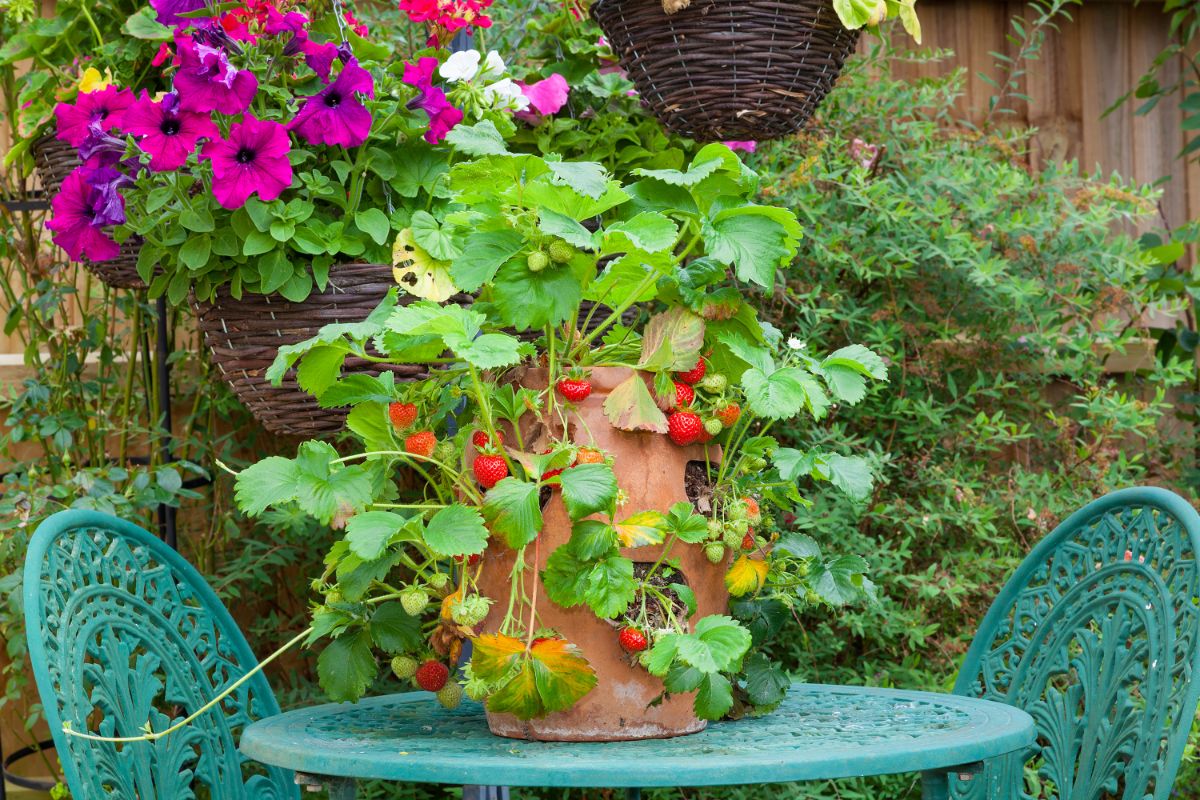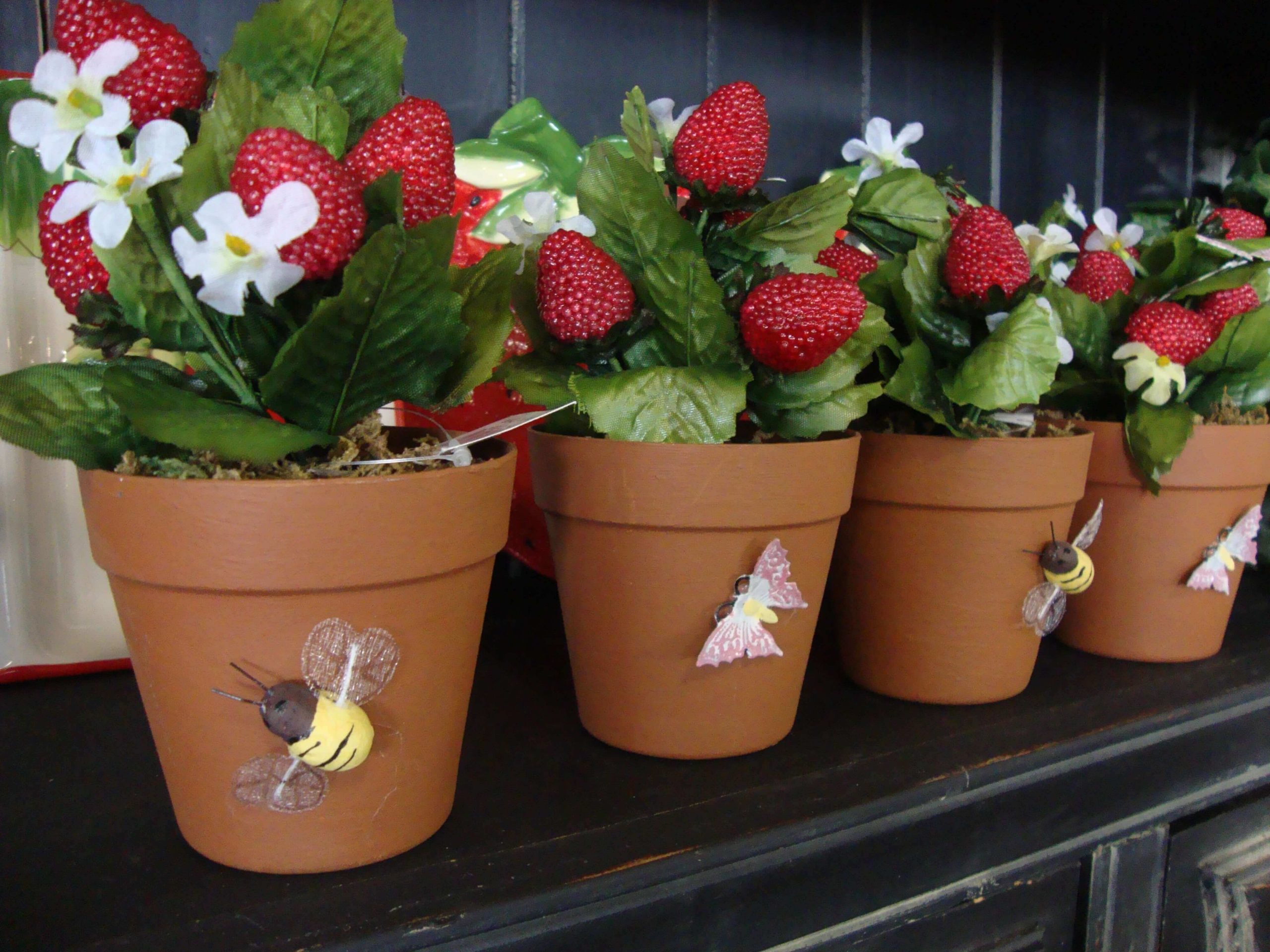I have a large container on my patio with strawberry plants in it. This was the 2nd summer for these strawberries. Unfortunately, the plants only put out a handful of strawberries back in early June. I was very disappointed to say the least. I went to a nearby nursery to ask them what I could do about my plants’ poor yield this summer.
The woman there told me that strawberries grown in pots don’t usually bear as many fruits as strawberries grown in the ground. She also asked me if I had fertilized my strawberry plants last fall before winter set in. I had never heard of doing this. Do you really want to feed a plant that is going to die in the winter? If that’s the case, when should I feed it? Right now, while it’s still green and alive, or when it starts to curl up and die in the winter? It’s important to note that I leave this pot outside on my patio all winter, uncovered and open to the snow and weather. This way, it made it through last winter and grew back beautifully this spring, so I didn’t have to do much to keep it alive. It survived! Also, what fertilizer, if any, do I use for this fall fertilization?[feast_advanced_jump_to].
Growing juicy sweet strawberries in pots is an easy way to produce berries even if you only have a small space. Container gardening with strawberries allows you to position plants in the optimal spot for sun exposure and offers more control over soil quality and drainage compared to planting in the ground. This comprehensive guide provides useful tips for successfully cultivating strawberries in pots.
Benefits of Potted Strawberries
There are several advantages to planting strawberries in containers
- Great for small spaces like patios, balconies and urban environments
- Convenient for harvesting – position pots near doorways or seating areas
- Avoid soil-borne diseases and pests like slugs
- Get better drainage and nourishment from potting mixes
- Easier to protect plants from frosts with coverings
- Ability to move pots into sunlight or shade as needed
Well-cared for strawberries grown in containers can be just as productive as those planted in garden beds. With the right strategies, you can grow sweet, bountiful berries in pots.
Choosing the Best Containers
Almost any container with adequate drainage holes will work for strawberries. Here are some ideal options:
- Ceramic, plastic or wooden pots/planters
- Hanging baskets
- Window boxes
- Vertical strawberry towers
- Metal or wooden barrels
- Raised beds with slatted wood sides
Aim for a depth of at least 8 inches but wider is better than deeper for strawberry roots. A 12-inch diameter allows for 2-3 plants. Match pot size to variety – June-bearers need more space than compact alpines.
Getting the Perfect Potting Mix
Quality potting soil is vital for healthy container strawberries. Aim for a loose, lightweight mix that holds moisture but drains well. Incorporate compost or organic fertilizer to provide nutrients. Opt for a sterile commercial blend rather than garden soil which compacts over time.
Selecting the Best Strawberry Variety
All strawberries grow well in pots but there are differences between June-bearing and everbearing types:
- June-bearers produce a large early summer crop over 2-3 weeks.
- Everbearing strawberries yield smaller harvests in early summer, late summer and fall.
- Alpine strawberries are petite plants with small berries from spring to fall.
When to Plant Strawberries
Spring is the ideal time to plant dormant bare-root strawberry crowns or actively growing starter plants. Plant as soon as the danger of frost has passed. Vegetative crowns establish slower than starter plants but cost less.
Simple Steps for Planting Strawberries in Containers
-
Fill container most of the way with quality potting mix.
-
Remove crowns/plants from packaging and spread roots out.
-
Plant at same level as roots, with crown above soil. Add more mix.
-
Gently firm down soil, water thoroughly until it drains from holes.
-
Choose a spot with at least 6 hours of direct sun daily.
-
Install support poles and bird netting if needed.
Ongoing Care and Maintenance
Follow these tips for healthy, productive container strawberries:
-
Water whenever top inch of soil is dry. Check pots daily in warm weather.
-
Fertilize monthly with a balanced liquid plant food.
-
Remove runners to focus growth on mother plants.
-
Protect from harsh weather and pests with covers.
-
Prune off dead leaves through season to prevent disease.
Dealing With Pests and Diseases
Common strawberry pests like birds, slugs, snails, and rodents can be kept away with netting and animal deterrents. Avoid overcrowding and promote airflow to prevent fungal and bacterial diseases. Monitor for signs of infestations and treat promptly. Introduce beneficial insects to manage aphids, mites, and other pests.
Overwintering Potted Strawberry Plants
Strawberries need a cold dormancy to produce flowers and fruit. Overwinter containers in a garage or under a deck after several hard frosts. Water sparingly, just enough to prevent desiccation. Insulate roots from freezing. Acclimate plants to spring weather gradually before placing them outside again.
Propagating Strawberries From Runners
As strawberry plants mature, they send out horizontal stems called runners that form baby clone plants. These can be cut off and rooted in small pots to propagate more strawberry plants. It’s best to remove most runners the first year and pot them up in subsequent seasons to avoid overcrowding.
Troubleshooting Problems With Container Strawberries
Here are some common issues and solutions:
-
Flowers but no fruit: Lack of pollination. Hand pollinate blossoms using a small brush.
-
Sparse foliage and stunted plants: Underfed. Fertilize regularly with a balanced plant food.
-
Leaves yellowing or browning: Overwatering or underwatering. Check soil moisture and adjust watering routine.
-
White fungus on leaves: Powdery mildew. Improve airflow and use fungicides.
-
Chewed leaves or berries: Pests like slugs, birds, rodents. Use netting or traps.
-
Few runners forming: Overcrowding. Thin plants and remove some runners.
Preventing Future Spider Mite Infestations
The best defense is prevention when it comes to avoiding problems with container strawberries:
- Start with disease-free crowns or starter plants
- Use sterile potting mix and clean containers
- Check new plants closely before introducing to others
- Provide optimal growing conditions
- Inspect regularly for signs of pests or disease
- Isolate and treat plants as soon as issues are spotted
With excellent care and favorable growing conditions, it’s easy to get a bountiful strawberry harvest from pots on a patio or balcony. Pay close attention to plants, act fast if problems occur, and reinvigorate containers with new plants every 2-3 years.
Answer to: Growing Strawberries in Containers…

Bob, Thanks for writing in and asking about the best way to grow strawberries in containers. Believe it or not, a lot of people write in to ask about different aspects of growing strawberry plants in hanging, mobile, or other smaller containers. And, like you, many people are less-than-thrilled with their results. To get things going in the right direction, let me say a few things. Next, I’ll list some of the most common issues people have when developing strawberries in containers.
First a little bit of information about the strawberry plant itself may be in order. Interestingly, strawberry plants don’t actually die in the winter if they are well taken care of or live in a place where the weather is mild enough. They enter a state of dormancy where they are still living, but only just barely. This reduces the metabolic demands that are present normally to a bare minimum. The leaves die back, plant functions slow to a crawl, and they surely do look dead. But when the weather gets warmer in late winter or early spring, they come back to life! Potted plants can even survive without any extra care in places with mild winters by soaking up the radiant heat that passes through house walls (as long as they are kept close enough).
6 Tips for Growing Strawberries in Containers
With that said, strawberries CAN be grown in containers successfully. They can even produce just as well in containers as their in-ground counterparts. People who put strawberry plants in pots outside in the wild should keep a few things in mind, though, since those plants don’t come from there. Remembering these tips will help your plants do well.
Planting Strawberries in Containers: Step-by-Step Guide for Beginners!
How do you grow a strawberry plant in a pot?
If the pot is plastic or metal, you can add extra holes using a drill. Strawberry plants have shallow roots, so a deep pot isn’t necessary, but they do like their space so opt for wide containers. In terms of soil, fill the pots with loamy potting soil that will hold moisture without getting boggy. 3. Choose Your Starter Plants
Can you grow strawberries in containers?
Strawberries are great plants to keep around the home. They’re as beautiful as they are edible, and growing strawberries in containers is easy. This is your foolproof guide to getting started, complete with everything you need to know to harvest delicious fruit next summer. Gardeners often choose strawberry plants based on their fruiting habits.
Are strawberries easy to grow in pots?
This article has been viewed 368,025 times. Thanks to all authors for creating a page that has been read 368,025 times. Strawberries are easy to grow in pots, thanks to their shallow roots. These plants simply require a wide, shallow pot, rich soil, and plenty of sunlight. Make sure to watch the plant carefully for signs of pests, fungus, and rot.
Can you plant strawberries in a potting mix?
If it goes into the potting mix very quickly, you are good to go for planting strawberries. However, if it creates a little pond of water on the surface, this is a sign that you either compacted the soil too hard into the pot or your mix is not well-drained enough. The best ingredients for ensuring drainage in strawberry pots include:
- The Ultimate Guide to Growing Strawberries in Raised Beds - August 8, 2025
- No-Dig Garden Beds: The Easiest Way to Grow a Beautiful Garden - August 6, 2025
- How to Protect and Preserve Wood for Raised Garden Beds - August 6, 2025

